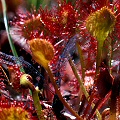Q: How many carnivorous plant species are there?
A: Below I have listed the numbers of species in each genus. You will have to add them up
yourself, because it's too much of a pain for me to do this everytime I add a new species to the FAQ.
There is not universal agreement
on how to group the groups of carnivorous plants into higher taxonomic entities,
but along with thoughtful analysis by the Angiosperm Phylogeny Group (APG),
and a string of publications from this groups, we are getting a workable system. Below you can see the system that is being
settled upon. This arrangement is partially based upon genetic characters, is still being refined.
This is not just an exercise in hypothesizing... Each distinct clade of carnivorous plants indicates a separate, distinct
time that the syndrome of carnivory developed by evolutionary pressures.
Below you can see the orders (first column, red text), families (second column, blue text), and genera with species information
(third column, green text) for all the carnivorous plant
genera. In this arrangement, I identify the
clades as enumerated on the previous FAQ page.
Note that in some of the genera, such as Brocchinia,
Catopsis, Passiflora, and
Stylidium, not all the species in the genus are considered potentially carnivorous. Oh, and by
"potentially carnivorous", I intend to convey the notion that the science is not completely compelling in some of these
cases.
I admit to a certain arbitrariness in these tables.
Some plants which are probably not truly carnivorous (such as Capsella bursa-pastoris)
have been excluded from the following tables, while others (such as
Ibicella and Passiflora have been included). This table is to
be read and interpreted by you.
Monocot Clade
- Poales Clade #1
- Bromeliaceae
- Brocchinia (2-3 potentially carnivorous species; approximately 20 species in the genus)
- Catopsis (1 potentially carnivorous species; approximately 20 species in the genus)
- Bromeliaceae
- Poales Clade #2
- Tofieldiaceae
- Triantha (1 carnivorous species; approximately 4 species in the genus)
- Tofieldiaceae
Superrosids Clade
- Oxalidales Clade #3
- Cephalotaceae
- Cephalotus (1 carnivorous species)
- Cephalotaceae
- Malpighiales Clade #8
- Passifloraceae
- Passiflora (1 probably non-carnivorous species; approximately 550 species in the genus)
- Passifloraceae
Superasterids Clade
- Caryophyllales Clade #4
- Dioncophyllaceae
- Triphyophyllum (1 carnivorous species)
- Droseraceae
- Aldrovanda (1 carnivorous species)
- Dionaea (1 carnivorous species)
- Drosera (245 carnivorous species, several subspecific taxa)
- Drosophyllaceae
- Drosophyllum (1 carnivorous species)
- Nepenthaceae
- Nepenthes (172 carnivorous species)
- Dioncophyllaceae
- Ericales Clade #5
- Roridulaceae
- Roridula (2 carnivorous species)
- Sarraceniaceae
- Darlingtonia (1 carnivorous species, one subspecific taxon)
- Heliamphora (23 carnivorous species, a few subspecific taxa)
- Sarracenia (11 carnivorous species, many subspecific taxa)
- Roridulaceae
- Lamiales Clade #6
- Byblidaceae
- Byblis (8 carnivorous species)
- Lentibulariaceae
- Genlisea (30 carnivorous species)
- Pinguicula (95 carnivorous species, many subspecific taxa)
- Utricularia (242 carnivorous species)
- Martyniaceae
- Ibicella (1 probably non-carnivorous species; approximately 3 species in the genus)
- Plantaginaceae
- Philcoxia (7 carnivorous species)
- Byblidaceae
- Asterales Clade #7
- Stylidiaceae
- Stylidium (unknown number potentially carnivorous species; approximately 300 species in the genus)
- Stylidiaceae
Page citations: APG 2016; Barthlott, W. et al. 2007; Juniper et al. 1989; Rice, B.A. 2006a; personal observations.


